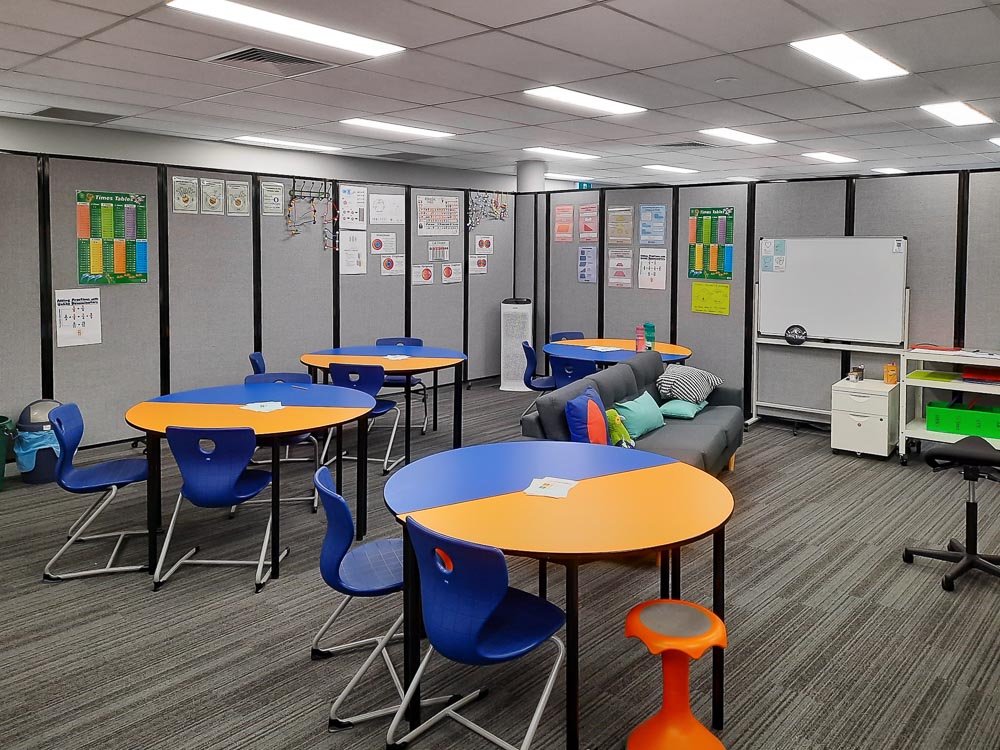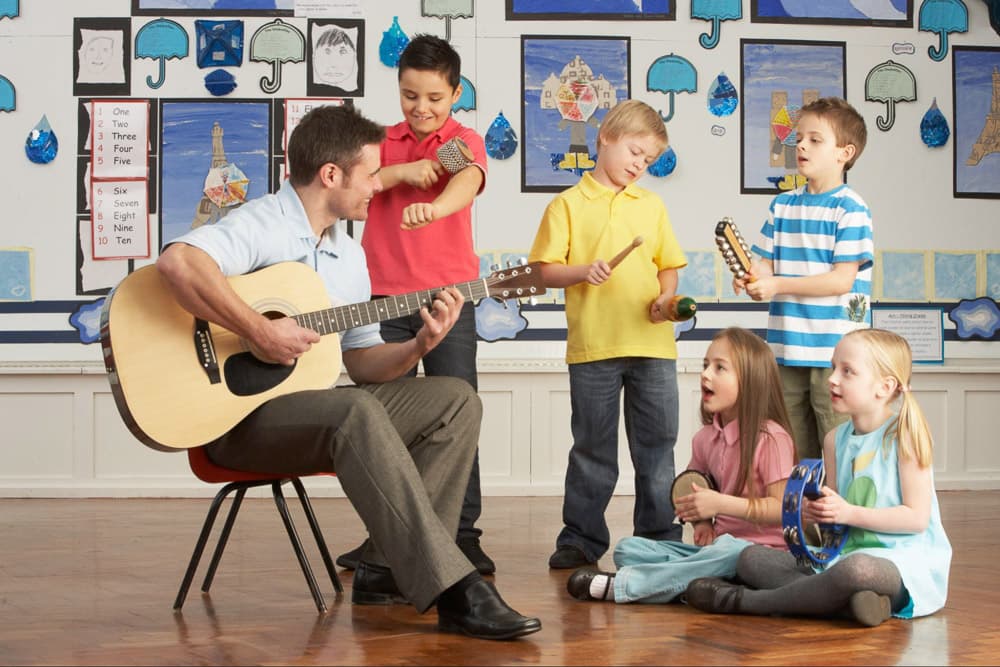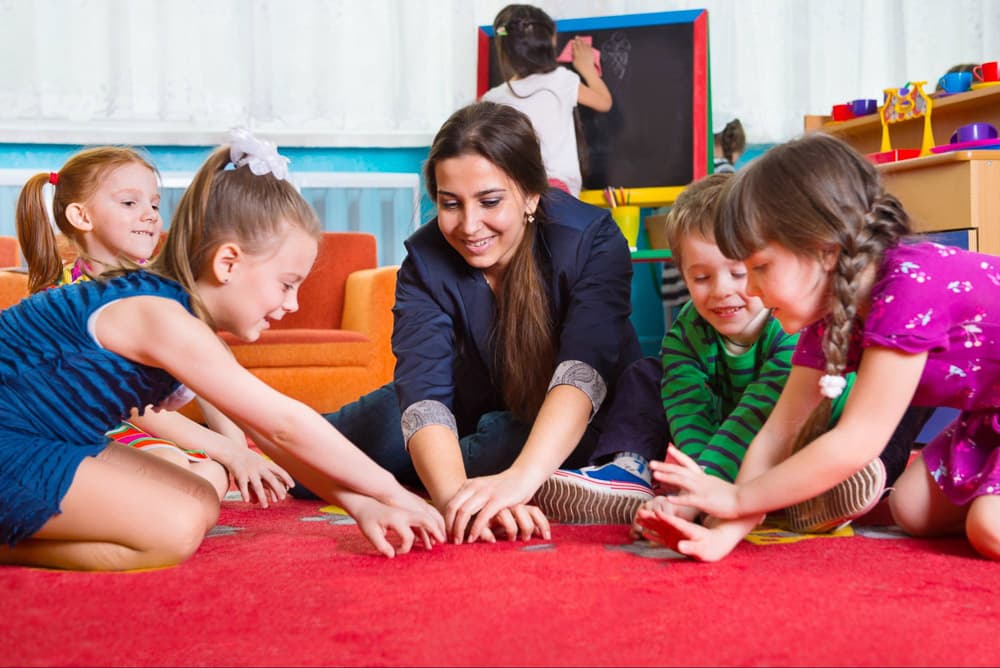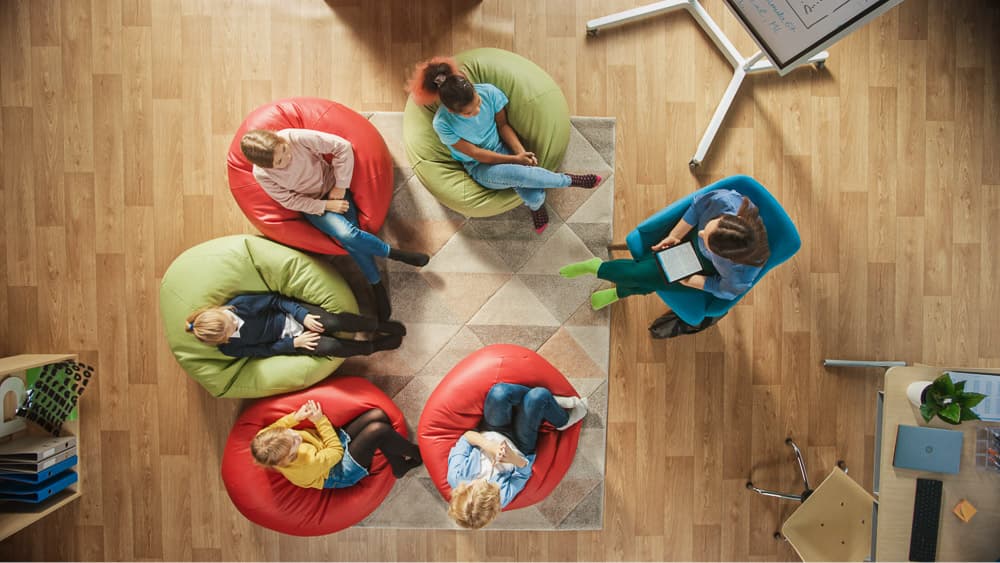Flexible Classrooms: The Learning Environment for Everyone
A flexible classroom is a learning environment in which students are given greater autonomy over how they learn.
With growing evidence that students learn better when given more options in the classroom, many schools are shifting away from traditional, teacher-centric learning models in favour of student-centric pedagogical approaches. Flexible classroom design plays a key role in this transformation, leading many teachers to adopt more flexible classroom layouts and seating arrangements that help facilitate these changes.
Today, we’ll introduce you to some of the core elements of flexible learning environments, and how they can benefit your students. We’ll also explore some methods of building flexibility into your own classroom design to support academic achievement.
Table of Contents
Flexible Classrooms: The Learning Environment for Everyone
- Flexible Classroom Insights
- What is Flexible Classroom Design?
- Structured Classrooms or Flexible Classrooms?
- The Benefits of Flexible Learning Spaces
4.1 The Flip Side: The Challenges of Flexible Classrooms - What Changes Could be Made to Improve Teaching in Flexible Classrooms?
5.1 Example of Flexibility in the Classroom - Elements of a Flexible Learning Environment
6.1 Flexible Classroom Layout
6.2 Innovative Classroom Seating
6.3 Create an Active Classroom Environment - How to Create the Best Flexible Classroom Design
- Additional Flexible Classroom Resources
What is Flexible Classroom Design?
By their very nature, flexible learning environments are varied and dynamic spaces where no two designs will be entirely the same. Flexible learning environments are best described as a combination of pedagogical practices, spacial designs, and classroom configurations that empower choice, turning traditionally static classrooms into personalised and interactive learning spaces.
Playing an essential role in classroom management, the physical design of a flexible learning environment empowers teachers and students to work and learn in a way that best suits their needs and preferences.
In short, ‘choice’ lies at the heart of every flexible classroom.
Structured Classrooms or Flexible Classrooms?
While the term ‘structured classroom’ may conjure up images of a traditional ‘rows and columns’ layout, structured and flexible learning environments are not mutually exclusive.
A well structured flexible classroom, supported by appropriate teaching methods, has been shown to be the best learning environment for students. An improperly planned flexible space, on the other hand, can lead to chaos.
Ideally, your classroom should be flexible enough to facilitate choice and support all modes of learning, but structured enough to create clear division between zones while minimising noise and disruption. The classroom should be laid out in a way that allows free movement throughout the space as well as access to all the materials, equipment, activities, and support students need to work at their best.
Examples of a structured classroom that incorporates elements of a flexible learning environment include:
- Diverse seating arrangements broken up into ‘zones’ that are dedicated to particular activities or styles of learning
- Semi-open spaces that can be rearranged using flexible seating and movable boundaries
- Strategically positioned classroom furniture that facilitates the smooth flow of traffic, allowing teachers and students to move around the room with ease
- Frequently used supplies kept in easily accessible locations
- Learning materials, posters, and visual presentations displayed in locations that are easy to see from anywhere in the room
- Wider gaps between furniture to prevent bottlenecks
- Varied seating options arranged in clusters so that students can choose where they sit and how they work

The Benefits of Flexible Learning Spaces
Flexible learning spaces offer many benefits over more traditional classrooms. In fact, the Clever Classrooms report found that ‘flexibility’ accounted for approximately 11% of classroom design’s impact on a child’s learning progress over the course of a year.
One study conducted by Katharina Kariippanon and Dylan Cliff from the University of Wollongong explored the perceived interplay between flexible learning spaces and teaching, learning, and student wellbeing. The study analysed the perceived effects of flexible spaces in primary and secondary schools in Australia by drawing on the perceptions and experiences of school principals, teachers, and students.
Flexible spaces were reportedly more enjoyable, comfortable, and inclusive, and also empowered greater interaction. The study concluded that a well-designed and well-utilised flexible learning environment offered increased autonomy while appearing to have a positive impact on teaching, learning and the overall wellbeing of students.
Further research has identified numerous other benefits to using a flexible classroom design that empowers students with choices:
- Better engagement
- Greater sense of ownership
- Enhanced motivation to learn
- Feel more valued and respected
- More alert and productive
- Reduced stress and anxiety
- Fewer extended periods of sitting
- Greater self-awareness of preferred learning modalities
- Enables new teaching strategies
- Better sense of community
- More opportunities to share knowledge with peers
- Allows cognitive maturation
- Enhances spatial awareness
- Burns excess energy while increasing heart rate and circulation
- Stimulate the release of beneficial chemicals by encouraging movement
The Flip Side: The Challenges of Flexible Classrooms
While many teachers are exchanging more traditional designs for flexible seating and classroom layouts, such learning environments may come with some trade-offs.
With an increased focus on collaboration, students are reportedly distracted more frequently in class. Flexible, open plan designs also come at the cost of privacy, and often result in an increase in negative behaviour in class. Students may also find it more difficult to find a space in which they can focus on independent work, which can potentially lead to frustration and annoyance.
To counteract some of the negative aspects of open plan classrooms, semi-open flexible learning spaces may give you the best of both worlds: offering greater privacy and more quiet study spaces while still maintaining the connectedness and collaborative atmosphere of an open plan space.
Carefully placed furniture, movable partitions, and greater distances between other classbase openings could also allow you to reap the benefits of an open plan design and a more traditional classroom.
What Changes Could be Made to Improve Teaching in Flexible Classrooms?
Creating a truly flexible learning environment is about more than just the design of the room; it means improving your teaching methods as well.
Flexible learning spaces need to be paired with pedagogies that incorporate a range of teaching techniques, including guided learning, whole-class group work, hands-on activities, project work, independent study, and practice assessments.
Example of Flexibility in the Classroom
An excellent example of flexibility in the classroom, the Universal Design for Learning – or UDL as it’s commonly known – is a set of principles for curriculum development that give all students equal opportunities to learn.
UDL is based on the idea that there’s no such thing as a ‘typical’ student, and that teachers must therefore use a combination of best practice approaches to engage students and encourage them to think critically. With a focus on adaptability and flexibility, UDL utilises a range of instructional modalities, formats, work spaces, and technologies to enable teachers to meet the varied learning needs of a diverse student body.
UDL is guided by three core principles for achieving flexibility and meeting individual student needs:
- Multiple modes of engagement: Tap into a learner’s unique interests, motivating them to learn
- Multiple methods of representation: Give learners access to a range of different ways of acquiring information and building knowledge
- Multiple means of action and expression: Allow learners to choose how they’d like to demonstrate knowledge
Universal Design for Learning is an excellent example of how a flexible space can be combined with pedagogies that account for the diverse needs and preferences of students, ensuring equal learning opportunities for all.


Elements of a Flexible Learning Environment
Creating a flexible learning environment can seem like a daunting task. Learning is an ongoing process, after all; and learning about learning should be no different. Every year, new challenges are arising and new studies are being conducted to help us understand the learning process so that teachers can better support students in the classroom.
Perhaps the most successful classroom design elements are those that offer the flexibility to adapt to new curriculum demands as well as new challenges.
The challenges of the Covid pandemic, for example, forced teachers to employ remote learning techniques that were largely untested until the events of 2020. Teachers learned much about learning styles and preferred learning modalities in the new normal. They also discovered how meeting these needs and preferences could improve academic performance during remote learning; lessons that will hopefully carry on into the physical classroom for years to come.
1. Flexible Classroom Layout
A flexible classroom layout is a space that’s dedicated to enabling choice. This means providing students with the opportunity to choose how they learn, how they demonstrate knowledge, and how they work with others.
Some ideas for setting up a flexible classroom layout include:
- Strategically placing furniture in a way that facilitates free movement without causing bottlenecks.
- Offering a range of writing surfaces and knowledge-sharing tools such as whiteboards, pinboards, sketch pads, and computers so students can decide how they wish to demonstrate what they’ve learned.
- For younger students, dividing classrooms into dedicated learning ‘zones’
- Gradually reducing the number of learning zones as you progress through the year groups – older students have been found to prefer larger and squarer rooms that contain fewer zones
While flexible classroom layouts are typically imagined as open plan spaces, experts are beginning to unearth evidence that such designs are not conducive to learning. Noise levels and children’s speech perception scores are instead found to be much better in semi-open layouts.
Such a layout may utilise walls, furniture, portable dividers, and other design elements to break up the space rather than leaving it entirely open. To minimise noise transmission and ensure adequate speech privacy, it’s also best to maintain a distance of at least 6.5m between classbase openings.
2. Innovative Classroom Seating
Successful flexible learning environments typically deploy a range of innovative seating arrangements and furniture options to facilitate both independent and collaborative learning. Offering flexible seating in your classroom design gives students greater autonomy over where and how they learn. For example, high school classroom design research shows that students who enjoy a greater sense of control over their education are often more focused, productive, and motivated to learn, while being less prone to distraction, discomfort, and annoyance in the classroom.
Flexible furniture often comprises of modular, lightweight, and portable versions of conventional furniture:
- Rolling chairs
- Bean bags
- Exercise balls
- Sit-stand desks
- Comfortable rugs and floor cushions
- Couches
Remember, incorporating innovative classroom seating into your flexible classroom design doesn’t necessarily mean eliminating traditional chairs and desks entirely. Some students still prefer more conventional seating, so make sure these options are still available to them.

3. Create an Active Classroom Environment
Contrary to popular belief, when students are able to move, fidget, rock, lean, and stand, they tend to stay more alert and focused in class. In fact, standing and moving around while studying and learning can offer a whole host of benefits to the brain and body:
- Improves alertness, attention and motivation
- Increases the ability to remember, recall, and understand new vocabulary
- Burns off the excess energy that can lead to distraction
- Improves executive functioning
- Boosts verbal memory, thinking, and learning
If you prefer students to remain seated, there are other ways of encouraging healthy activity. Try incorporating short breaks into your schedule so students can stand up, stretch, and even change seats if they need. Things such as wobble chairs, yoga balls, and floor cushions can also help students stay a little more active in the classroom without standing up and disrupting the class.
How to Create the Best Flexible Classroom Design
A successful flexible classroom design is measured by how well the space caters to relevant age groups, teaching styles, ability levels, and learning preferences. This is why there can never truly be a ‘one size fits all’ solution.
Here are some tactics to help you confidently create the best flexible classroom design for your students.
Seek Student Feedback
Students know what they like. Conduct a discussion about which elements of the classroom are working for them and which ones aren’t. You can then make changes accordingly.
Provide Plenty of Options
From seating options to different methods of demonstrating learning, choice is the name of the game in a flexible learning environment.
Try offering a variety of chairs, learning spaces, desk arrangements, and writing options so your students can choose alternative methods of gaining and sharing knowledge. Your students’ choices will grant you valuable insight into how they work best and what they prefer in the classroom. This may help you further optimise your teaching methods and classroom for the future.
Test Existing Flexible Classroom Layouts
Designing a flexible classroom layout from scratch can be difficult. If another teacher has already established a flexible classroom layout and seating arrangement at your school, you may wish to organise a visit so you can see it in action.
Ask the teacher what problems they had to overcome in creating the space, and try to gather any insights as to whether the design is a match to your own goals and teaching style.
Be Flexible About Your Own Teaching
Flexible classroom design and seating arrangements are only half the battle. Flexible layouts are most effective when backed by an equally flexible teaching style.
Mix up your teaching methods, give students plenty of options, and optimise for all learning styles. You may even want to invite guest speakers into your classroom to vary the learning experience and keep your students engaged throughout the year.
Experiment
Humans are naturally inclined to stick to what they know, but ‘familiar’ doesn’t always mean ‘better’.
Be willing to experiment with alternative options. Remember, each new year may introduce new challenges or learning preferences, so be prepared to experiment from year to year to provide the best environment every time.
Try encouraging your students to experiment with their own learning as well, whether that be suggesting they try sitting in a different seat, or urging them to choose a different assignment from usual to test their knowledge.
Make Gradual Changes
Sweeping changes can make it difficult to determine what’s working in the classroom and what’s not. It’s best to implement changes one at a time so you can assess the results and determine whether something is helping or hindering student performance.
This gradual approach can also help reduce the amount of time it takes students to adjust to modifications to the classroom.
Additional Flexible Classroom Resources
- Increase Flexibility in the Classroom with our range of Classroom Dividers
- Classroom Design: Australia’s Ultimate Guide






